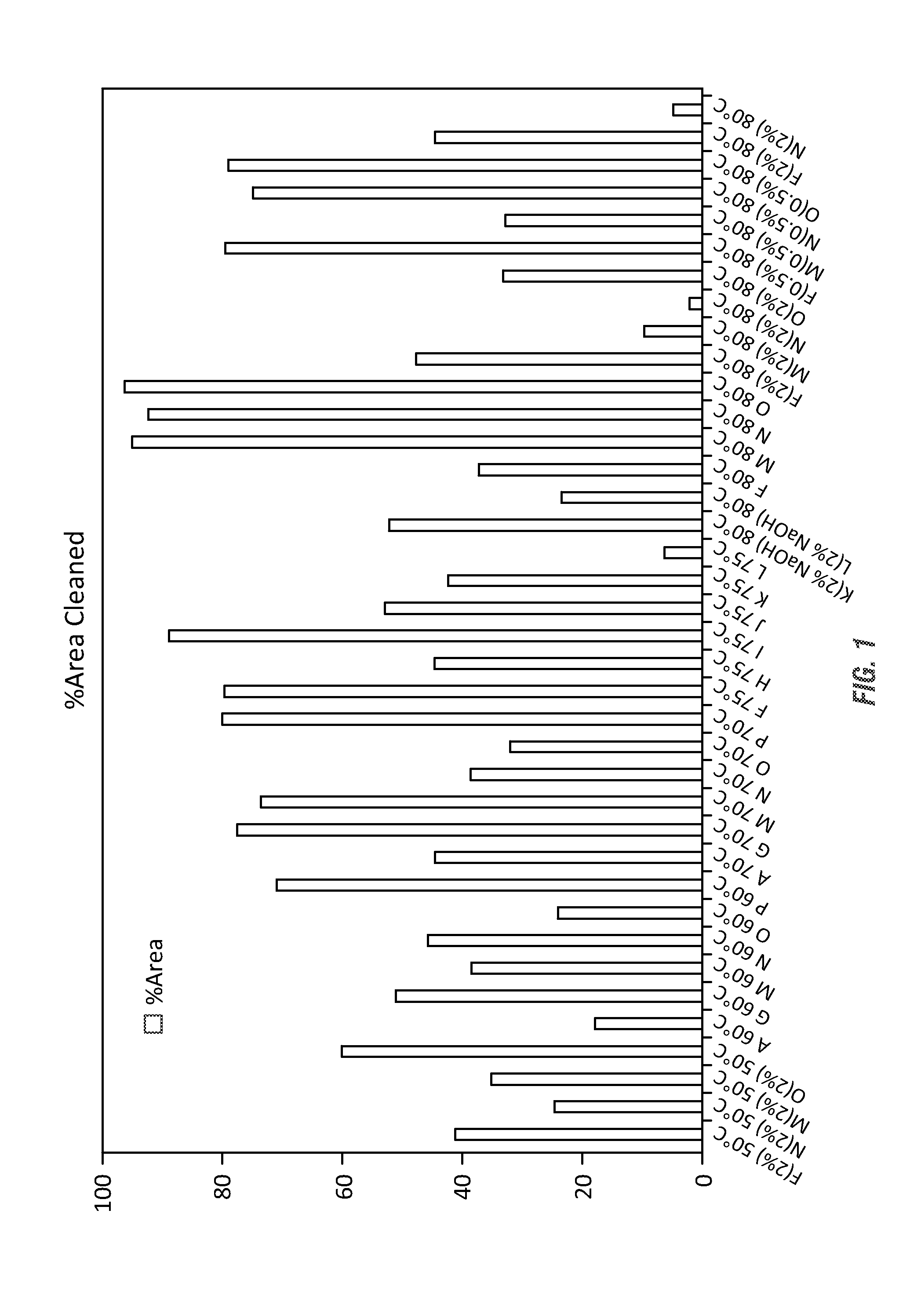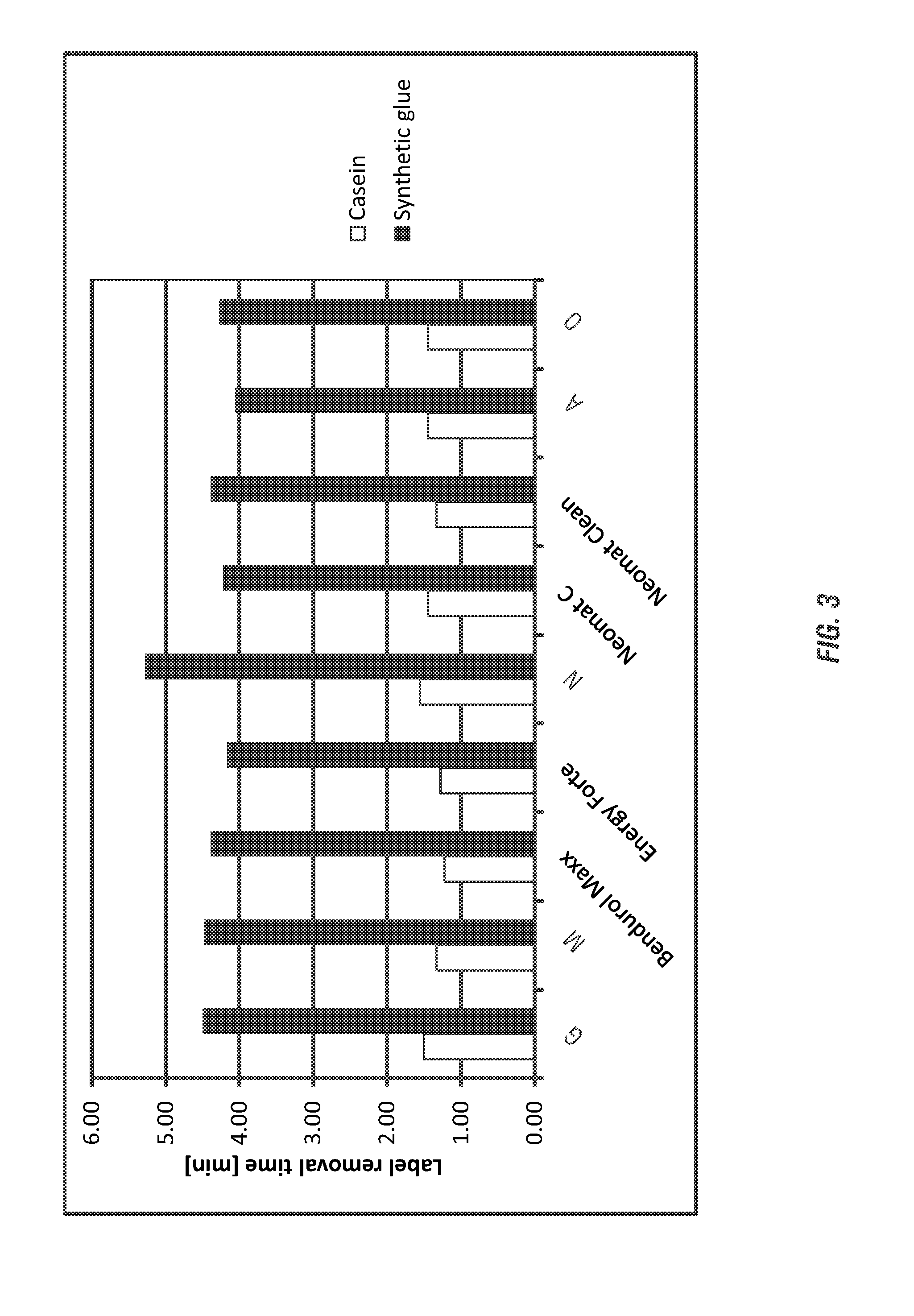Label removal solution for low temperature and low alkaline conditions
a technology of low temperature and low alkaline conditions, applied in the preparation of inorganic non-surface active detergent compositions, detergent compounding agents, detergent mixture compositions, etc., can solve the problem of increasing the buildup of cleaning solutions, partially removing labels and/or destroying labels, and reducing the use of items
- Summary
- Abstract
- Description
- Claims
- Application Information
AI Technical Summary
Benefits of technology
Problems solved by technology
Method used
Image
Examples
example 1
[0156]Various adhesive paper labels used in commercial glass bottling were analyzed to determine the compositional make-up of the different label adhesives (Optal LG 11, Colfix s8012 and Turmer Leim ST 50 KF). The labels and adhesives are outlined in Table 2.
TABLE 2FrontBackCommercial Bottle LabelLabel AAlkyl ester,Celluloseacrylic speciesLabel BKaolin, ester,Carbonate, alkyl,alkylacrylic, celluloseLabel CAlkyl ester,Carbonate, alkyl,acrylic speciesacrylic, celluloseLabel AdhesiveOptal LG 11(Synthetic) Alkyl ester, carboxylic acid saltColfix S8012(Synthetic) Alkyl ester, carboxylic acid saltTurmer Leim ST 50 KFAcrylamide, melamine casein
[0157]The compositional analysis of the various paper bottle labels and adhesives, including the functional groups identified, support the use of a polar and / or basic solvent (e.g. benzyl alcohol (polar), furfurylamine (basic)) to provide the effective bottle label removal formulation according to the invention. Namely, the use of the solvent in a cl...
example 2
[0158]The labels and adhesives examined in Example 1 were tested under various bottle washing conditions to determine the efficacy of label removal from glass slides. Each adhesive and paper label was affixed to a glass slide and the slides were placed, for the amount of time specified in a 3 L glass beaker on a hot place to achieve the specified temperatures set forth below. The labels were then peeled from the glass slide by hand and the glass slides were rinsed with cold water. The slides were then visually analyzed to determine the efficacy of each solution. The greater amount of residues remaining on the slides indicate a poorer performance.
[0159]Caustic Solution.
[0160]A 2% NaOH solution was evaluated for label removal performance on the three different adhesives at 75° C.-80° C. for 10 minutes with no agitation. Glue residue remained on all slides; it was visible as lighter patches on each slide. The 2% NaOH was not as effective on Optal LG 11 as it was on Colfix S8012 or Turm...
example 3
[0166]The efficacy of the cleaning compositions to remove Optical LG 11 adhesive labels from glass bottles within a shortened period of time was analyzed. Testing of various formulations at increasing temperatures (from 50° C. to 80° C.) were conducted to determine the percentage of area cleaned by a tested solution within 5 minutes using the methods described in Example 2.
[0167]Various surfactants, solvents and other cleaning agents were screened for efficacy in adhesive removal according to the methods of the invention. Initially, cleaning agents screened included: ionic fluids / surfactants Cola®Solv IES and OES; RhodiaSolv Infinity surfactant; dimethylaminopropylamine solvent; dimethylcyclohexylamine; diethylcyclohexylamine; 1,8-diazobicyclo[5.4.0]undecene-7-ene; tris[2-(2-methoxyethoxy)-ethyl]amine.
[0168]The subsequently evaluated formulations evaluated are shown in Table 4 and described herein.
TABLE 4ComponentsFGHIJKLBayhibit AM (50%)1.036.701.101.061.001.07Citric acid4.935.264....
PUM
| Property | Measurement | Unit |
|---|---|---|
| Temperature | aaaaa | aaaaa |
| Temperature | aaaaa | aaaaa |
| Time | aaaaa | aaaaa |
Abstract
Description
Claims
Application Information
 Login to View More
Login to View More - R&D
- Intellectual Property
- Life Sciences
- Materials
- Tech Scout
- Unparalleled Data Quality
- Higher Quality Content
- 60% Fewer Hallucinations
Browse by: Latest US Patents, China's latest patents, Technical Efficacy Thesaurus, Application Domain, Technology Topic, Popular Technical Reports.
© 2025 PatSnap. All rights reserved.Legal|Privacy policy|Modern Slavery Act Transparency Statement|Sitemap|About US| Contact US: help@patsnap.com



